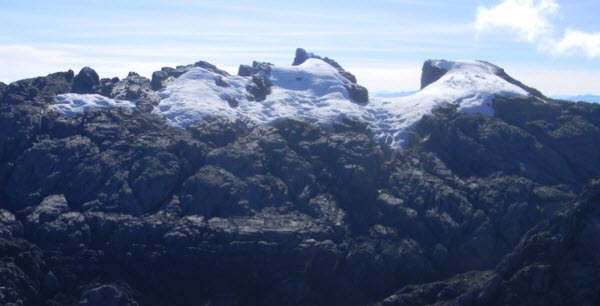The rapidly vanishing glaciers of West Papua have made a rocky tower called Sumantri the second highest peak in Indonesia.
Although not yet officially reclassified, Sumantri, 4870 metres (15,977 feet) is now noticeably higher than an adjacent peak Ngga Pulu, which has lost its glacial cap and is down to 4862 metres.
Until about 2000 anyone who schlepped up the crevassed glacier that lay across the way to the top of Ngga Pulu , then No.2 high point, would have looked across and down a chaotic landscape of rock blocks and receding ice to the lower tip of Sumantri, No.3 “peak”. But not any more.
A self portrait by French mountaineer Philippe Gatta on the snow dusted newly rocky summit of Ngga Pulu shows him overshadowed by the tip of Sumantri in the background .
It is a spectacular indication of global warming but one only seen by a small number of cashed-up peak baggers who pay more than $10,000 in some instances to climb nearby Puncak Jaya (formerly Carstenz Pyramid) which at 4884 metres is the highest point in Oceania or Australasia, and part of the so-called Seven Summits of Earth.
Access to what are the nearest glaciers to Australia, yet only four degrees south of the equator, is complicated by the peak bagger unfriendly policies of the gigantic high altitude US-controlled Freeport copper and gold mine within sight of Puncak Jaya and the formalised bribery required to get permission to skirt it and fly to a base camp by helicopter, which avoids what amounts to a war zone between Papuan separatists and Jakarta.
Recent estimates say the broken glacial masses that remain on the middle to upper slopes of the southern sides of Sumantri and Ngga Pulu (left and right in the photo below) will melt away in 15 years or less.

That photo, taken last month, clearly shows the lowered height of Ngga Pulu, and was published as part of a detailed report on Summit Post.
While prone to snow falls, the peaks also get washed by torrential rains, and rain always wins over snow. When a Dutch expedition jungle-bashed its way inland to climb Ngga Pulu in 1936 it measured its altitude at 5130 metres, making it easily the highest point in Oceania.
But by the time Carstenz Pyramid, devoid of glacial ice, was first climbed in 1962, it was clearly higher than any other peak in West Papua. Now that Ngga Pulu’s glacier has shrunk away from the summit the total ice loss that has exposed the bed rock has been 258 metres in about 64 years.
What were known as the “snow mountains” of New Guinea will soon be the “ghost mountains”, haunting the clouds that still plaster them with brief snow falls.








Another excellent piece on a inexplicably ignored topic Ben.
There is more recent comment here, from world-renowned tropical glaciologist Lonnie Thompson. He gives it just 5 years.
Also see a broader image I generated some years back, showing the proximity to the Freeport mine pit. Rio Tinto still owns a slice of this extraordinarily destructive operation.
It would be interesting to know if there is any evidence of the rate of glaciation and, particularly, retreat or loss of glaciation, during the Holocene, given that there have been many examples in many parts of the world, as some sort of reality check on the natural leap-to-conclusion view that this has to do with unprecedented (rates of) and alarming global warming.
We know that the original melting of ice absorbs a great deal of latent heat but, presumably, a reduction in cloud cover over glaciers for any reason would counteract any cooling effect from melting by allowing more direct radiant energy from the sun to increase the rate of melting. Reduction in cloud cover could, just as a layman’s guess, result from a combination of factors which might include local cooling and katabatic winds. It would be good to read something from someone with serious technical knowledge.
Hmmm… funny that almost ALL the worlds tropical glaciers are retreating. Kilimanjaro, the ones in S.America too. Must all be due to “local cooling” and “katabatic winds”? Could never have anything to do with the fact that the earth has warmed, could it, Julius?
@GregB
You miss the point of my inquiry. Of course (as I made plain) it might have something to do with global warming. But what are the mechanisms? And what have been the mechanisms?
It is precisely because the energy absorbed to melt ice would have a cooling effect locally that the possibility of there being some greater cumulative warming mechanism is of particular interest.
I take it that you don’t possess the “serious technical knowledge” I referred to but please don’t please bother to substitute again careless reading and sloppy logic as the basis for a reply.
Julius,
The best model of ice loss according to most glaciologists is that of Roger Braithwaite (http://www.sed.manchester.ac.uk/geography/staff/braithwaite_roger.htm, papers referenced at end) who links ice/snow melt to the time integrated temperature above zero, or ‘Positive Degree Day’. Although the Holocene Climatic Optimum was a local maxima in radiation, paleotemperatures in most parts seem to be only a few degrees warmer than today (http://www.springerlink.com/content/e5y0kj0lpm1wwyw2/) and glaciers responded more to climatic variability (http://www.knmi.nl/~weber/abstracts/abstr6.html). So I don’t think cloud cover is seen to play a major role.